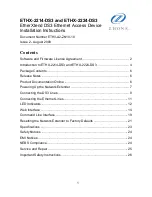
S
PANNING
T
REE
A
LGORITHM
C
ONFIGURATION
3-157
The spanning tree algorithms supported by this switch include these
versions:
•
STP – Spanning Tree Protocol (IEEE 802.1D)
•
RSTP – Rapid Spanning Tree Protocol (IEEE 802.1w)
•
MSTP – Multiple Spanning Tree Protocol (IEEE 802.1s)
STA uses a distributed algorithm to select a bridging device
(STA-compliant switch, bridge or router) that serves as the root of the
spanning tree network. It selects a root port on each bridging device
(except for the root device) which incurs the lowest path cost when
forwarding a packet from that device to the root device. Then it selects a
designated bridging device from each LAN which incurs the lowest path
cost when forwarding a packet from that LAN to the root device. All ports
connected to designated bridging devices are assigned as designated ports.
After determining the lowest cost spanning tree, it enables all root ports
and designated ports, and disables all other ports. Network packets are
therefore only forwarded between root ports and designated ports,
eliminating any possible network loops.
Once a stable network topology has been established, all bridges listen for
Hello BPDUs (Bridge Protocol Data Units) transmitted from the Root
Bridge. If a bridge does not get a Hello BPDU after a predefined interval
(Maximum Age), the bridge assumes that the link to the Root Bridge is
down. This bridge will then initiate negotiations with other bridges to
reconfigure the network to reestablish a valid network topology.
RSTP is designed as a general replacement for the slower, legacy STP.
RSTP is also incorporated into MSTP. RSTP achieves must faster
reconfiguration (i.e., around 1 to 3 seconds, compared to 30 seconds or
x
Designated
Root
Designated
Port
Designated
Bridge
x
x
x
Root
Port
x
Summary of Contents for 8708L2
Page 2: ......
Page 24: ...TABLES xxiv ...
Page 28: ...FIGURES xxviii ...
Page 290: ...CONFIGURING THE SWITCH 3 238 ...
Page 584: ...COMMAND LINE INTERFACE 4 294 ...
Page 592: ...TROUBLESHOOTING B 4 ...
Page 605: ......
















































